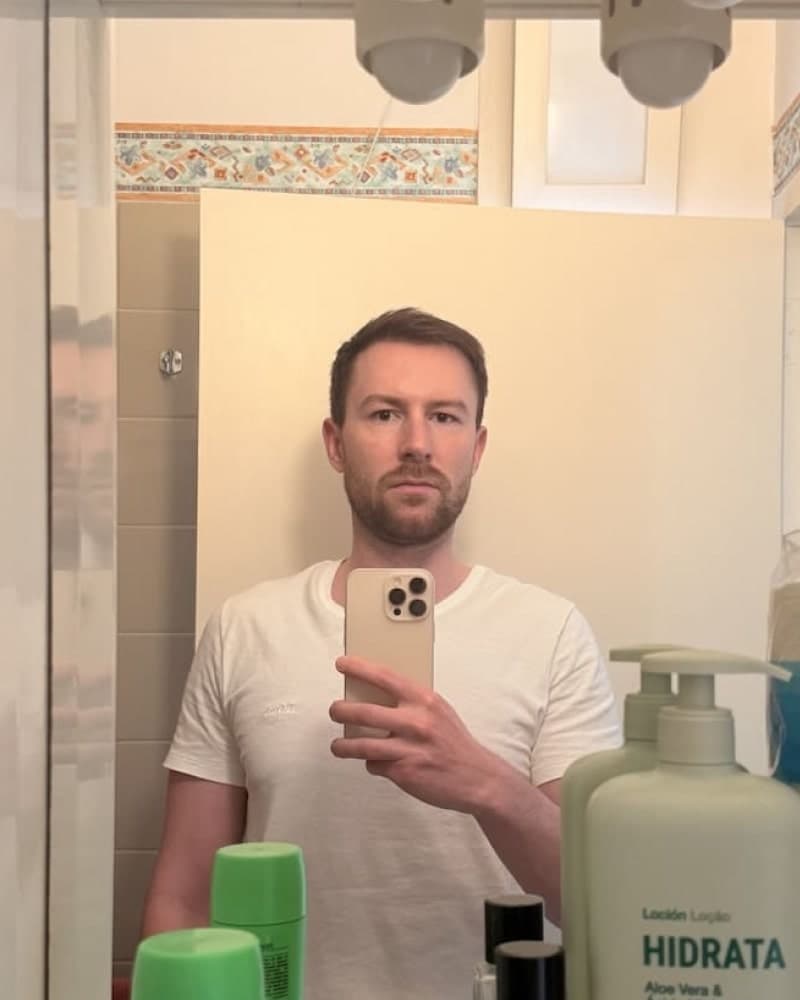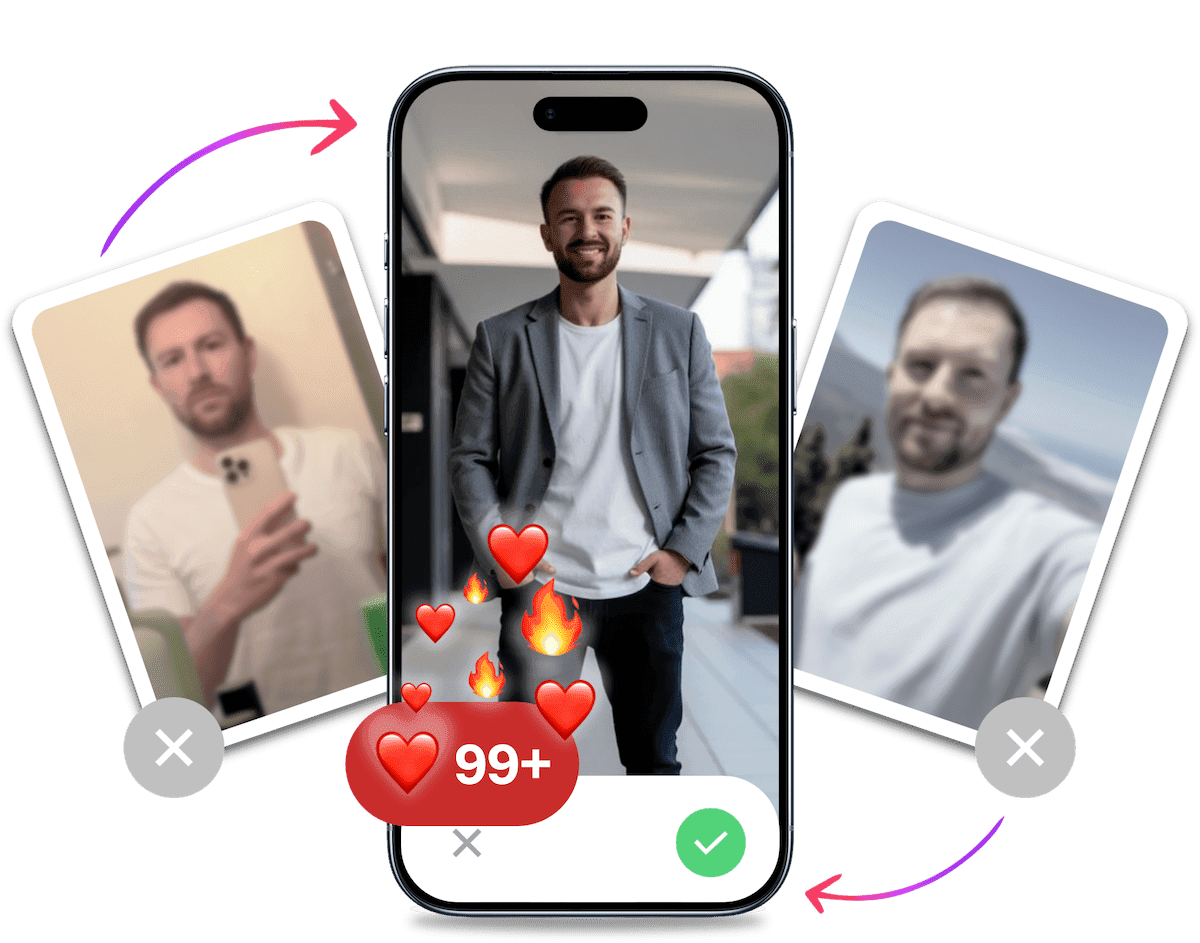
The 2025 Guide to Stable Diffusion for Dating Photos (And Why It’s Not Worth Your Time)
Creating impressive Stable Diffusion dating photos seems like a genius move to get an edge on Tinder, Hinge, or Bumble. But here’s the problem: Stable Diffusion is a powerful tool for developers, not a simple fix for your dating profile. It's a frustrating, time-consuming nightmare for this purpose.
This guide will walk you through the entire process, from setup to the final image. Then, we'll show you a 10-minute alternative that delivers better results with zero technical headaches.
The Seductive Promise: Why Blokes Are Turning to Stable Diffusion
Let's be honest, the appeal is obvious. You want better photos to get more matches, but professional photo shoots are expensive and can feel awkward. The idea of a "techy" solution, where you control the outcome from your computer, is incredibly tempting.
The goal is clear: create a diverse set of high-quality, confident, and approachable photos that look completely real. You want to showcase the best version of yourself, and AI seems like the perfect tool for the job. We get it. The promise is amazing.
The Reality Check: The 5-Step Gauntlet to a Single Good Photo
The journey from idea to a usable photo is less of a straight line and more of a brutal obstacle course. We're not just talking about clicking a few buttons. This is a multi-stage project that requires time, technical skill, and a lot of patience.
Step 1: The Setup Nightmare - Choosing Your Weapon (Local vs. Cloud)
Before you even think about your face, you have to become an IT specialist. To run Stable Diffusion locally, you need a high-end computer, specifically one with a powerful NVIDIA graphics card (GPU) with tons of VRAM. This isn't your average gaming rig.
The setup process involves:
- Installing Python (and making sure it's the right version).
- Using Git to clone software repositories from the internet.
- Downloading and configuring CUDA drivers to let your software talk to your expensive GPU.
Don't have a $1500 graphics card? Your alternative is using cloud services like Google Colab or RunPod. This introduces a new set of complexities, plus recurring costs. You're literally paying to do the hard work yourself.
Step 2: The Raw Materials - Training a Model on Your Face
Stable Diffusion doesn't know what you look like. You have to teach it. This is done by training a custom model, often using methods called LoRA or Dreambooth.
To do this, you need to feed it raw materials. That means gathering 15-20 high-quality, well-lit, and varied photos of yourself. For many blokes, this is the first major roadblock. If you had 20 amazing photos, you might not be reading this article!
Once you have your dataset, the model needs hours of "training time" to learn your facial features. It’s a time-consuming process that you have to get just right for it to work. Having good Tinder pictures to start with is a hurdle most people can't clear.
Step 3: Prompt Engineering - Becoming a Part-Time Poet
You don't just "ask" Stable Diffusion for a picture. You have to write a complex "prompt" that describes every single detail of the image you want to create. This is more of an art form than a science.
What's the difference between a beginner and an expert? Just look at the prompts.
Basic Prompt: "photo of man on a beach"
Advanced Prompt: "RAW photo, subject (ohwx man), professional colour grading, diffused soft lighting, shallow depth of field, 85mm lens, bokeh, looking at viewer, confident smile, casual t-shirt, beach sunset background"
And that's not all. You also need to write "negative prompts" to tell the AI what to avoid, like "deformed hands, mutated fingers, extra limbs, blurry, ugly, disfigured." It's a steep, frustrating learning curve that requires both artistic and technical skill.
Step 4: The Uncanny Valley - Endless Tweaking and "Bad Batches"
Your reward for all that setup and prompting? A folder full of digital nightmares. Stable Diffusion is infamous for its failures, which often include:
- Mangled, six-fingered hands.
- Dead, lifeless eyes.
- Skin that looks like plastic.
- Bizarre artefacts in the background.
The process is iterative. You'll generate hundreds of images in "batches" just to find a few candidates that aren't immediately terrifying. You'll spend hours tweaking settings like CFG scale, samplers (Euler a, DPM++), and steps, often without knowing what they actually do. The success rate for creating realistic AI dating photos this way is incredibly low.
Step 5: The Finishing Touches - Post-Processing and Selection
Even if you strike gold and get a decent image, you're not done. The best outputs from Stable Diffusion almost always require touch-ups in professional software like Adobe Photoshop or Lightroom to look truly real. You’ll need to adjust colours, fix small imperfections, and add a bit of grain to remove that "too perfect" AI sheen.
Then comes the challenge of consistency. You might get one good photo in a suit, but will it look like the same person from the "candid" coffee shop photo you generated? Creating a cohesive set of believable photos is yet another mountain to climb.
The Big Question: Do Stable Diffusion Photos Even Work on Dating Apps?
This is the most important question. After all that work, does it actually help you get more matches? The answer is a shaky "maybe," but the risk is huge.
People have a built-in "AI detector." We can sense when something looks too perfect, too glossy, or just slightly off. If a woman senses your photo isn't authentic, it shatters trust instantly. That's a swipe left, every single time.
Our goal is to create photos that look like they were taken by a talented friend on a good day. It's you, just at your very best.
That's the philosophy behind a specialised service. It contrasts sharply with the often sterile, fake, or uncanny look of DIY AI. While Stable Diffusion photos can work, the effort-to-reward ratio is terrible, and the risk of looking like you're using fake pictures is dangerously high. It's one of the biggest dating profile mistakes men make.
No Likes? No Replies?
It's Probably Your Photos.


Average users see 8x more right swipes with our AI photos. Stop wasting time on dating apps and join 50,000+ singles who have already found better dates with TinderProfile.ai.
The 10-Minute Solution: Skip the Hassle, Get Better Results
Now that you understand the immense effort required for the DIY method, let's talk about the smart alternative. You've seen the problem; here's the solution.
Introducing TinderProfile.ai: The Dating Photo Specialist
We built TinderProfile.ai specifically to solve this problem for dating apps. We are the specialist, not the generalist. We've done all the hard work so you don't have to.
Let's compare it directly to the process we just walked through.
- No Technical Setup: Instead of installing drivers and code, you just visit our website.
- Simple Upload: Instead of curating a perfect 20-photo dataset, you just upload 5-10 selfies you already have on your phone.
- Zero Prompting: Instead of learning to write complex prompts, you just click a button. Our AI is already trained for this specific purpose.
- Authentic Results: Instead of getting 99 bad images for every good one, you get a curated gallery of 100+ photos engineered to look authentic and attractive on dating apps.
How We Solved the "Uncanny Valley" Problem
Why are our results so much better for dating? It's simple. Our AI is a specialist. A generalist tool like Stable Diffusion is trying to be everything to everyone—it can create dragons, spaceships, and portraits. It's a master of none.
Our AI was built exclusively for dating. It has been trained on what works for a Tinder profile. It understands the nuances of a confident smile, natural lighting, and an approachable vibe. We focus solely on creating authentic AI dating photos, not fake-looking avatars.
See the Difference: Stable Diffusion vs. TinderProfile.ai
The choice becomes pretty clear when you see it laid out side-by-side.
| Feature | Stable Diffusion (DIY Method) | TinderProfile.ai (Specialist Solution) |
|---|---|---|
| Time Investment | 10-20 hours of learning & setup | 10 minutes |
| Technical Skill | High (coding, prompt engineering) | None (just upload photos) |
| Cost | "Free" (if you have a $1500 GPU) or Cloud computing costs ($10-$50+) | $29 one-time fee |
| Success Rate | Very low (hundreds of bad images) | High (100+ curated, quality photos) |
| Realism | Prone to "uncanny valley" & fake look | Optimised for authenticity and realism |
| Purpose | Generalist Art Tool | Specialist Dating Photo Tool |
Conclusion: Stop Being a Technician, Start Getting Matches
Your goal is to get more dates, not a Ph.D. in AI image generation. Think about it. The hours you would spend wrestling with Python scripts, writing prompts, and deleting folders of mangled images could be spent swiping, messaging, and going on actual dates.
Your time is valuable. Don't waste it becoming a technician for a tool that's not even built for the job. You have a problem: your photos aren't getting you the matches you deserve. We have the solution.
Stop tinkering and start matching. Get your AI-optimised dating photos in the next 10 minutes.
Frequently Asked Questions about Stable Diffusion Dating Photos
Can you really create realistic AI dating photos with Stable Diffusion? Yes, it is technically possible, but it is extremely difficult. It requires advanced knowledge of prompt engineering, model training (LoRA/Dreambooth), and post-processing in software like Photoshop. For the average user, the results are often unrealistic and fall into the "uncanny valley," which is a major turn-off on dating apps.
Is Stable Diffusion better than Midjourney for dating photos? Both Stable Diffusion and Midjourney are powerful generalist AI art generators. Stable Diffusion offers more control if you have the technical skill to train a model on your face, but it's far more complex. Midjourney is easier to use but struggles to maintain facial consistency, often producing images that don't look like you. Neither is optimised for the specific goal of creating authentic dating app photos.
What's the biggest mistake people make with AI dating photos? The biggest mistake is prioritising perfection over authenticity. Many AI tools create images that are too glossy, too symmetrical, or have a plastic-like skin texture. People on dating apps are looking for a real person, not a flawless avatar. A photo that looks obviously AI-generated can break trust and lead to an immediate left swipe.
How does TinderProfile.ai ensure photos look authentic? Our platform is built on an AI model trained exclusively for this purpose. We've fine-tuned our algorithms to prioritise realism, focusing on natural lighting, candid poses, and textures that look genuine. We avoid the overly-polished look and aim for "taken by a friend" quality, ensuring you look like your best self, not an artificial version of yourself.
